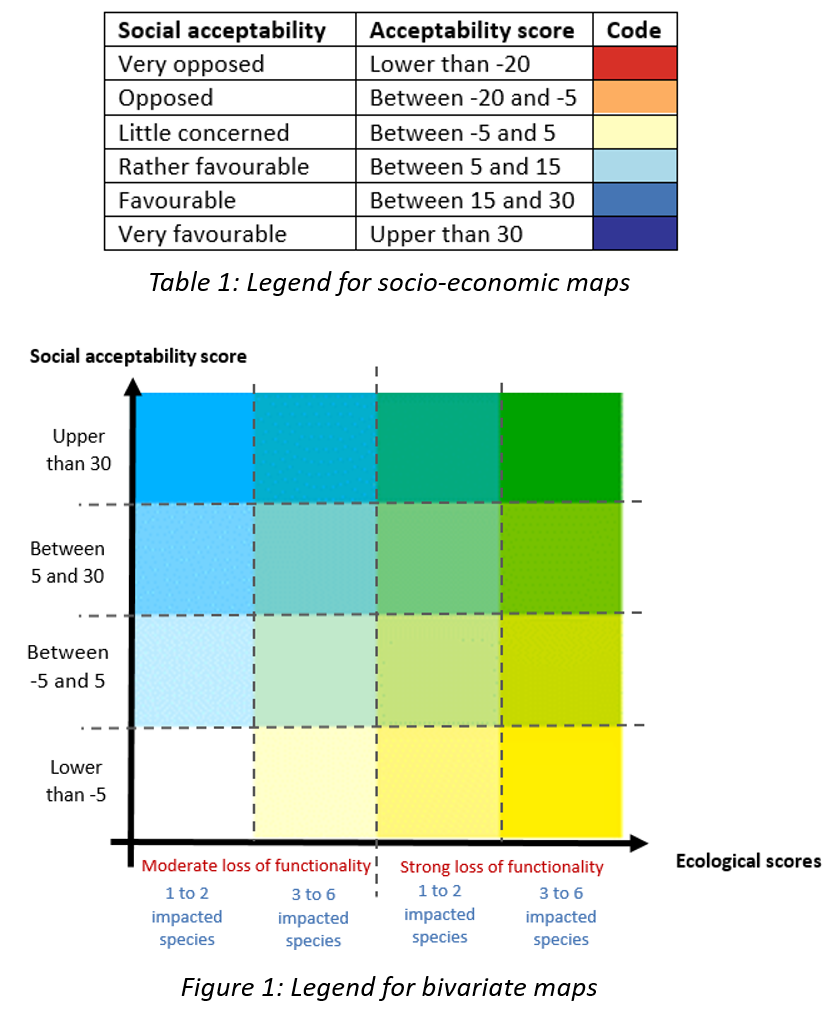
This web application is associated with the project "POLLUM: Création d'un outil d'aide à la définition de la trame noire à partir d'images satellites nocturnes à très haute résolution" (POLLUM: Tool for the definition of a dark infrastructure from very high-resolution night-time satellite images) funded by the Occitanie region and led by La Telescop and INRAE Montpellier, and with the article "Planning sustainable lighting for biodiversity and society" ([1]). The objective is to develop a spatial analysis to find the best lighting compromises for biodiversity and society in the Montpellier Metropolitan Area. To this end, three analyses were carried out: analysis of (i) light pollution and (ii) ecological stakes, led by La Telescop supported by three naturalist associations (OPIE, LPO and Groupe de Chiroptère du Languedoc Roussillon), and (iii) an analysis of social acceptability of mitigation measures coordinated by INRAE Montpellier (UMR TETIS). The report ([2]) (in french) is available here.
The web app is complementary to the project report, enabling easier, more flexible and user-friendly visualization of the results. It is composed of four tabs that we present here in reverse order:
- The last tab, "Light Pollution Indicator", presents the indicator from sections II.B.3 of [2] and 2.1 of [1], which measures upward emissions on a 1-meter grid. This data was estimated using high-resolution RGB images from the Jilin-1 satellite over the Montpellier Metropolitan Area during cloud-free nights in 2022. Indicators for visible light sources within 500m and 100m, relevant for assessing light pollution's impact on insect and bat dispersion, as detailed in II.B.3 of [2] and 2.1 of [1], are too data-intensive and take too long to load in this app but can be provided upon request.
- In the third tab, "Ecological Indicators", you can visualize maps of ecological stakes related to light pollution in the Montpellier Metropolitan Area (MMA) (section 2.2 of [1]). Six groups of species particularly sensitive to light pollution are represented: european nightjars, amphibians, insects living in wetlands, lampyridae and two bats genera: Myotis spp and Rhinolophus spp. For each groups of species, you can view (i) the predicted impact of light pollution on dispersion according to ecological stakes (evaluated in the absence of light pollution) (Section V.A.1 of [2]), and (ii) on biodiversity reservoirs (Section III.B of [2]). The application does not allow to visualize the impact of light pollution on amphibian dispersion, due to the small number of areas affected. Biodiversity reservoirs for bats (Rhinolophus spp and Myotis spp) cannot be visualized either, due to data confidentiality. Additionally, this tab provides global indicators of ecological stakes. The "global score" is derived from the combination of ecological stakes without light pollution (high or moderate), connectivity loss of potential in reservoirs and dispersion areas (high, moderate, or low), and the number of affected species groups (from 1 to 2 or from 3 to 6). "Priority areas for light pollution mitigation policies" corresponds to the same indicator allocated to the relevant light-emitting point (Section V.C.1 of [2]).
- The second tab, "Socio-economic indicators", corresponds to the social acceptability indicators of public lighting extinction (Section IV.D of [2]) (based on two publications, [3] and [4]). The indicators correspond to an average "acceptability score" per IRIS (i.e., an infra-municipal level) for two policies: light extinction from 1 a.m. to 5 a.m. and from 11 p.m. to 6 a.m. (Table 1)
- The first tab "Summary map", displays a summary map of the ecological stakes and social acceptability of light pollution mitigation measures. It displays bivariate maps of the social acceptability score (either for extinction from 1 a.m. to 5 a.m. or for extinction from 11 p.m. to 6 a.m.) and the previously described global ecological indicators "Priority areas for light pollution mitigation policies", either for high or moderate ecological stakes without light pollution (Figure 1).
Contributors
Sarah Potin, Julie Chaurand & Vincent Delbar (La Telescop)
Léa Tardieu (INRAE, TETIS and CIRED), Chloé Beaudet, Maia David (AgroParisTech, PSAE) & Léa Mariton (CESCO, MNHN)
[1] Tardieu L, Beaudet C, Potin S, Chaurand J, Mariton L, Delbar V, David M (submitted). Planning sustainable lighting for biodiversity and society.
[2] Potin S, Chaurand J, Beaudet C, Tardieu L. POLLUM : Création d'un outil d'aide à la définition de la trame noire à partir d'images satellites nocturnes à très haute résolution : Rapport Final. La TeleScop; INRAE. 2024, 66 p.
[3] Beaudet C, Tardieu L, David M (2022). Are citizens willing to accept changes in public lighting for biodiversity conservation? Ecological Economics 200, 107527, https://doi.org/10.1016/j.ecolecon.2022.107527
[4] Beaudet C, Tardieu L, Crastes Dit Sourd R, David M (submitted). Mapping preferences derived from a choice experiment: a comparison of two methods.